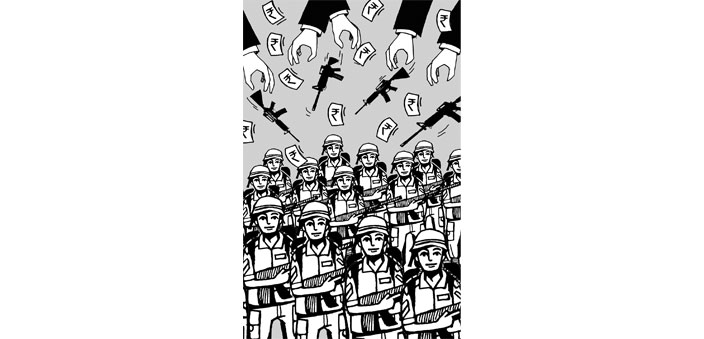We have fought major conventional wars against two neighbours, China and Pakistan. Threats from these two countries have to be incorporated into our strategic goals. It is imperative to take note of the rise of the extremist Islamic movement, Pakistan’s desperate bid for Kashmir through “inflicting a thousand cuts”, and the massive increase in China’s military strength. Military strategy is often influenced by economic and ethnic reasons. We have been thinking too narrowly by concentrating on threats, and should realise that a big nation may need to project its military power overseas to protect its own interests, or sometimes join international missions like keeping the Singapore channel open, or counter sea piracy. Future wars will require joint operations by the three Defence Services, and responsive civil-military understanding.
The Pakistan factor
Our major concerns for national security are two external sources, i.e., Pakistan and China. Pakistan, since 1947, has been continuously engaged in hostilities, mainly in Kashmir, which erupted into conflict in 1965, when both countries launched operations across the international border, without any substantial result. Pakistan has changed its strategy after the 1971 war; now it uses insurgents and terrorists to cross into our territory and create havoc, and try to topple the civil administration. In 1998, the Kargil intrusions were another unconventional method to create chaos in Ladakh. Inspite of their failures, they have continued to use proxy agents, jihadi elements of Afghanistan and from the Taliban, to continuously create border intrusion and major flare ups in the state of Jammu & Kashmir. Even though the strength of their army is lower than the Indian army, it has adequate armour and artillery to quantify its offensive task. In addition, they have the backup of various insurgent groups who provide good strength to their military establishment. Further, China as its new ally is capable of providing troop strength and logistics to aid any limited offensive operations.
In a broader perspective, while Pakistan is able to defend its border adequately, its Air Force it has to be mentioned, though smaller than ours, has a good modern inventory which can deliver a punch, or thwart our offensive tactics. An analysis of the last 10 years of Pakistan military thinking would reveal that they will not launch any major operation, but will keep on creating local intrusions with the aid of other insurgent groups that are well motivated to support the jihadi culture. Due to good equipment upgradation, Pakistan army can also launch limited operations in Kashmir and Rajasthan that could cause attrition to our forces.
The China factor
China’s military strength and economic might is a big factor in our perception of threat. They have a military strength of over 20,00,000 troops, of which one lakh can be mobilised at its Tibetan Command, which can directly attack our forces in the North and East. The Chinese army can also operate 30,000 airborne troops who can operate very close to the Sino-Indian borders. They have an excellent inventory of tanks, artillery and missiles, which can support their offensive tasks. In Tibet, the Chinese have built excellent roads, railways and airbases, which are all-weather status.
The Chinese Navy with its large fleet of 350 numbers of various war ships and 60 submarines, today dominates the Indian Ocean and the South China Sea. The China-Pakistan economic corridor that is being developed from Tibet to western Pakistan, will help them to move additional forces to the POK (Pakistan-Occupied-Kashmir) region. On the other hand, we have troops stationed at a lower level who have to move uphill against the grain of the land. A number of strategic roads which have been sanctioned by the government, have not yet been completed.
The wide gap
Both the Indian Navy and the Indian Air Force have developed slowly in the last decade to fulfill their tasks in operations. However, their growth has not been sizeable to fulfill this strategic task. Equipment wise, the Air Force is short of 25% to 30% of the total assessed operational strength, which includes fighter aircraft, missiles and transportation fleet.The Indian Air Force certainly doesn’t have the adequate fleet strength to provide operational capabilities if there are hostilities on both fronts, i.e., East and West.
We have about 3,000 tanks such as Arjun, T90, T72 and T55. Most of them are worn-out. Replacements and modernisation have being lagging. It is understood that nine regiments will be replaced with latest technology tanks which are superior in all aspects. However, we need to procure another 900 tanks like T90MS, which are now offered by Russian sources.
For the artillery, we need urgent replacement of over 1000 units, as we have not obtained new guns since the Bofors scandal hit the country. Some of the important requirements are:
The complicated logistics
Much has been written about the problems of procurement, acquisition and replacement of the military hardware by the defence ministry. While there are various financial constraints which need to be understood, the ordinary citizen is not aware of the complex procedure of defence procurement and acquisition. It starts with projection of requirement by the armed forces headquarters, which then proceeds through various stages of vetting, negotiation, approval and financial allotment by the government. Even the identification of the item and its qualitative description is a complex procedure. Though India’s defence forces have been supported by a large number of ordnance factories, public sector units and defence research laboratories, for major items we have been heavily dependent on imports from countries such as Russia, America, France and Israel. Since the last two decades, it has been noticed that the defence ministry is not able to match up to the requirements of hardware due to complex procedures, bureaucratic hurdles and long span of logistics. Only recently, the defence ministry has framed various procedure policies that give greater clout to private sector, and collaboration between foreign arms manufacturer and a local partner. The government has also set up new bodies such as the Defence Acquisition Council, Acquisition Board and special committees to stream line the process of acquiring costly equipment. It is now realised that unless we collaborate more with private sector units, we cannot launch joint sector ventures that can outpace the ordnance factories. In fact, the government ought to even fund in a systematic manner private sector giants, to launch major ventures in artillery, weapons, tanks, submarines and even aircraft manufacturing.
Our border challenges
We have a long border with Pakistan, China, Bhutan, Nepal, Bangladesh and Myanmar. The terrain varies from deserts to the plains, mountains, and extremely thick jungles interposed with rivers. Our defence system is based on a combination of fencing, man power patrolling and aerial surveillance. In these efforts, we are hampered by a number of factors such as diffused authority, lack of adequate foot prints, hostile local population, and climatic disturbances.
To give an example, in the western border, the BSF (Border Security Force) and the Indo Tibetan Border Force (ITBF) support the Indian army, but in the eastern theatre, the role is given to ‘Seema Suraksha Bal’, Assam Rifles, and the Indian army. The border forces come either under the operational control of the defence ministry or the home ministry. Naturally, there is lack of coordination at the lower levels which hamper speedy response. Even in manpower resources, the deployment in the borders of Ladakh, Arunachal Pradesh and Bangladesh need quantitative upgradation supported by adequate technological devices and air surveillance. Authority of various sectors must be vested with the Indian army for coordination, based on the operational criteria as stated by the service headquarters.
While it is not possible to discuss the force levels of the Indian army, it needs to be stressed that in the eastern sector, the army headquarters had recommended an increase in the force level by an additional 60,000 troops. Though the government had accepted this three years ago, there is still poor implementation of the sanctioned additional formations due to various financial hurdles. This needs to be resolved with political will so that the Indian army’s capability matches the intent. Another worrying factor is the almost 20 percent shortage of junior officers, which severely affects the operational capability.
The ‘civilian’ army
Aid to civil power is a very important facet of the army’s role in national security. These can be summarised in the following manner:
On counter insurgency both in Jammu and Kashmir, Nagaland and Manipur, there is widespread concern about our inability to stem the rot. For this, three issues need to be tackled at the highest level:
The tendency of the government to start enquires as a result of human rights agitation, needs to be curbed.
Conclusion
The most important issue is the lack of a unified higher command at the national level when operations break out. At present there is a chief of staff committee shared by the senior most serving chief in rotation. Various groups and committees have recommended strongly that India must have a Chief of Defence Staff who will tender single window advice to the cabinet. Such a system is well adopted in many advanced countries such as UK and USA, but we are still dragging our feet.
While this article has focused on the factors such as equipment, manpower, strategy and command, it must be borne in mind that our budget allocation for defence is approximately 1.8% of the GDP, which needs to be stepped up to a more reasonable level of 2.75%.
Last year’s allocation of approximately 2.6 lakhs crores was just a nominal increase, with the result that our capital expenditure is restricted. The demand of the services has always been pruned down by the Ministry of Finance which results in paltry modernisation. Delay in the approval of various projects can also be traced to the many financial controls. Unfortunately, the services cannot carry forward the lapsed amount to the next financial year. Major reforms are needed on this topic including the placement of service officers in the Ministry of Defence as a part of integration.
We have large gaps in the intelligence system that affects our operational coordination. The agencies such as IB (Intelligence Bureau), RAW (Research and Analysis Wing) and military intelligence are working under different authorities; however, collation and dissemination are tardy.


 [/column]
[/column]